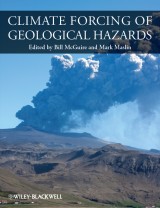Details

Climate Forcing of Geological Hazards
1. Aufl.
|
CHF 94.00 |
|
| Verlag: | Wiley-Blackwell |
| Format: | |
| Veröffentl.: | 29.11.2012 |
| ISBN/EAN: | 9781118482643 |
| Sprache: | englisch |
| Anzahl Seiten: | 328 |
DRM-geschütztes eBook, Sie benötigen z.B. Adobe Digital Editions und eine Adobe ID zum Lesen.
Beschreibungen
<p><i>Climate Forcing of Geological Hazards</i> provides a valuable new insight into how climate change is able to influence, modulate and trigger geological and geomorphological phenomena, such as earthquakes, tsunamis, volcanic eruptions and landslides; ultimately increasing the risk of natural hazards in a warmer world. Taken together, the chapters build a panorama of a field of research that is only now becoming recognized as important in the context of the likely impacts and implications of anthropogenic climate change. The observations, analyses and interpretations presented in the volume reinforce the idea that a changing climate does not simply involve the atmosphere and hydrosphere, but also elicits potentially hazardous responses from the solid Earth, or geosphere.</p> <p><i>Climate Forcing of Geological Hazards</i> is targeted particularly at academics, graduate students and professionals with an interest in environmental change and natural hazards. As such, we are hopeful that it will encourage further investigation of those mechanisms by which contemporary climate change may drive potentially hazardous geological and geomorphological activity, and of the future ramifications for society and economy.</p>
<p>List of Contributors</p> <p>Foreword<br /> Bill McGuire and Mark Maslin</p> <p>Chapter 1: Hazardous responses of the solid Earth to a changing climate<br /> Bill McGuire</p> <p>Chapter 2: Future climate changes in the context of geological and geomorphological hazards<br /> Felicity Liggins, Richard Betts and Bill McGuire</p> <p>Chapter 3: Climate change and collapsing volcanoes: evidence from Mount Etna, Sicily<br /> Kim Deeming, Bill McGuire and Paul Harrop</p> <p>Chapter 4: Melting ice and volcanic hazards in the twenty-first century<br /> Hugh Tuffen</p> <p>Chapter 5: Multiple effects of ice load changes and associated stress change on magmatic systems<br /> Freysteinn Sigmundsson and others</p> <p>Chapter 6: Response of faults to climate-driven changes in ice and water volumes at the surface of the Earth<br /> Andrea Hampel, Ralf Hetzel and Georgios Maniatis</p> <p>Chapter 7: Does the El-Niño – Southern Oscillation and influence earthquake activity in the eastern tropical Pacific?<br /> Serge Guillas, Simon Day and Bill McGuire</p> <p>Chapter 8: Submarine landslides and tsunamis in a changing climate<br /> Dave Tappin</p> <p>Chapter 9: Heat waves and slope stability in high mountain terrain<br /> Christian Huggel and others</p> <p>Chapter 10: Impacts of recent and future climate change on natural hazards in the European Alps<br /> Jasper Knight, Margreth Keiler and Stephan Harrison</p> <p>Chapter 11: Assessing the past and future stability of global gas hydrate reservoirs<br /> Mark Maslin, Matthew Owen, Richard Betts, Simon Day, Tom Dunkley Jones and Andrew Ridgwell</p> <p>Chapter 12: Methane hydrate instability: a view from the Palaeogene<br /> Tom Dunkley Jones, Andrew Ridgwell, D. J. Lunt, Mark Maslin, D. N. Schmidt and Paul Valdez</p> <p>Index</p>
<p>"Overall, this publication should be on the bookshelf of geologists, physical geographers, hydrologists, ecologists, environmental scientists, politicians, and anyone interested or involved in climate change. The wealth of concise information makes it an excellent reference for teaching the interdisciplinary aspects of environmental science and climate change." (<i>Int. J. Environment and Pollution</i>, 1 October 2013)</p> <p>“Further, this book convincingly demonstrates the need for greater inclusion of the geoscience research community in discussions on climate change adaptation and disaster risk reduction planning.” (<i>Geological Journal</i>, 25 February 2014)</p> <p>“I heartily recommend this book. We all have a stake in surviving climate change.” (<i>International Journal of Environmental Studies</i>, 20July 2013)</p> <p>"There is useful and interesting material in the book, very much worthy of attention…” (<i>Geology Today</i>, 1 May 2013)</p>
<p><b>Bill McGuire</b> is Professor of Geophysical and Climate Hazards at University College London. In 2005 he was a member of the UK Government's Natural Hazards Working Group, established in the wake of the Indian Ocean tsunami, and in 2010 was part of the Government Scientific Advisory Group for Emergencies, set up to address the ash problem associated with the Icelandic Eyjafjallajökull eruption. He is a contributing author of the 2012 IPCC report on climate change and extreme events.</p> <p><b>Mark Maslin</b> is Professor of Palaeoclimatology and Climate Change at University College London. He is a leading scientist with particular expertise in past and future global and regional climatic change and has published over 120 papers in journals such as <i>Science</i>, <i>Nature</i>, and <i>Geology</i>. He is a Royal Society Wolfson Research Merit Scholar and currently holds a Royal Society Industrial Fellowship.</p>
<p><i>Climate Forcing of Geological Hazards</i> provides a valuable new insight into how climate change is able to influence, modulate and trigger geological and geomorphological phenomena, such as earthquakes, tsunamis, volcanic eruptions and landslides; ultimately increasing the risk of natural hazards in a warmer world. Taken together, the chapters build a panorama of a field of research that is only now becoming recognized as important in the context of the likely impacts and implications of anthropogenic climate change. The observations, analyses and interpretations presented in the volume reinforce the idea that a changing climate does not simply involve the atmosphere and hydrosphere, but also elicits potentially hazardous responses from the solid Earth, or geosphere.</p> <p><i>Climate Forcing of Geological Hazards</i> is targeted particularly at academics, graduate students and professionals with an interest in environmental change and natural hazards. As such, we are hopeful that it will encourage further investigation of those mechanisms by which contemporary climate change may drive potentially hazardous geological and geomorphological activity, and of the future ramifications for society and economy.</p>
Diese Produkte könnten Sie auch interessieren:

Decision Support Systems for Risk-Based Management of Contaminated Sites

von: Antonio Marcomini, Glenn Walter Suter II, Andrea Critto

CHF 118.00

Dynamics of Mercury Pollution on Regional and Global Scales

von: Nicola Pirrone, Kathryn R. Mahaffey

CHF 177.00














